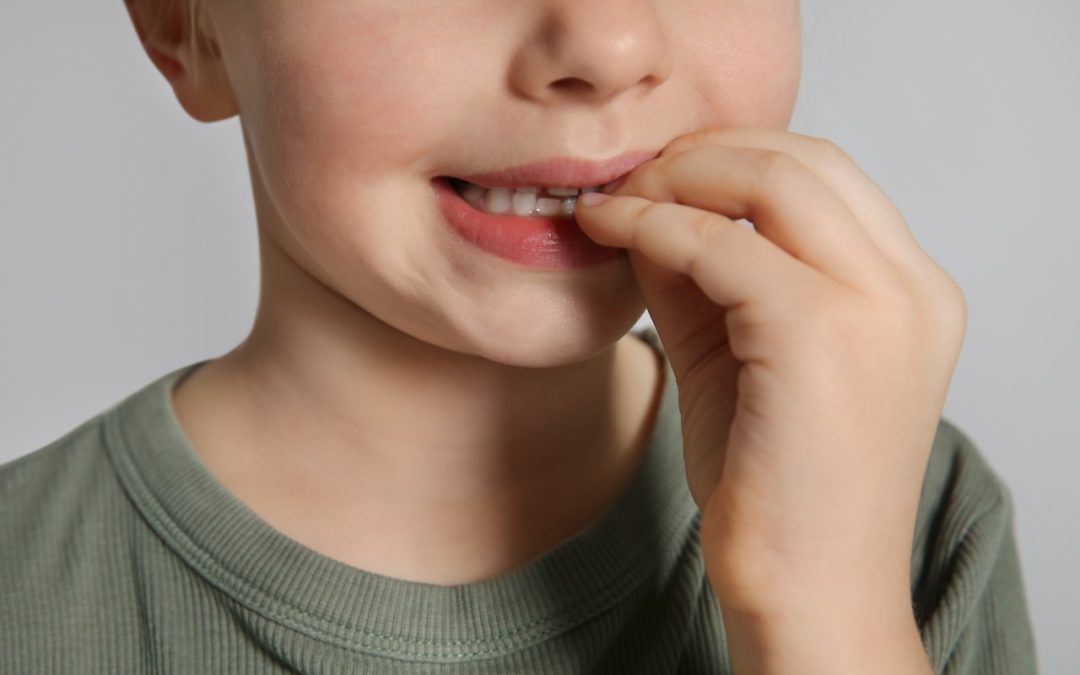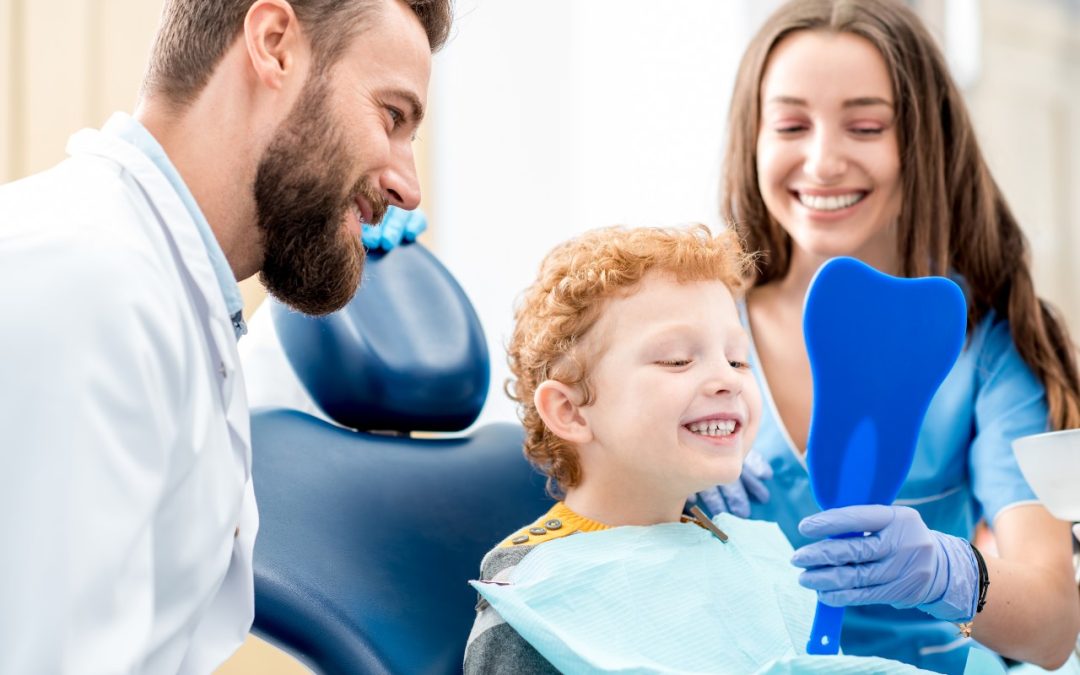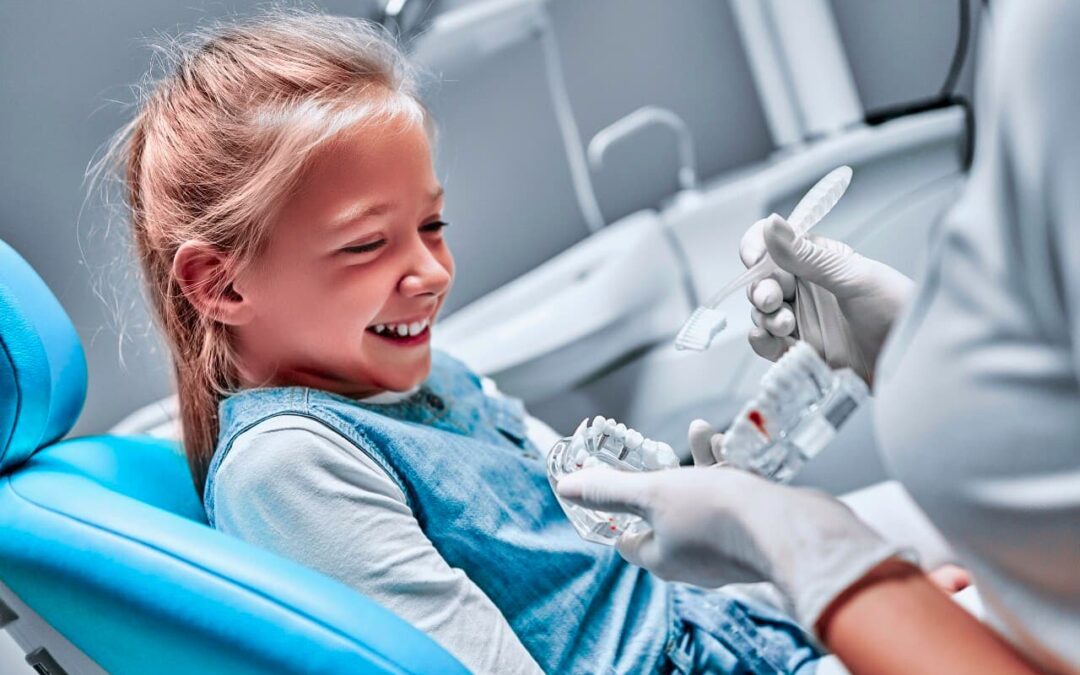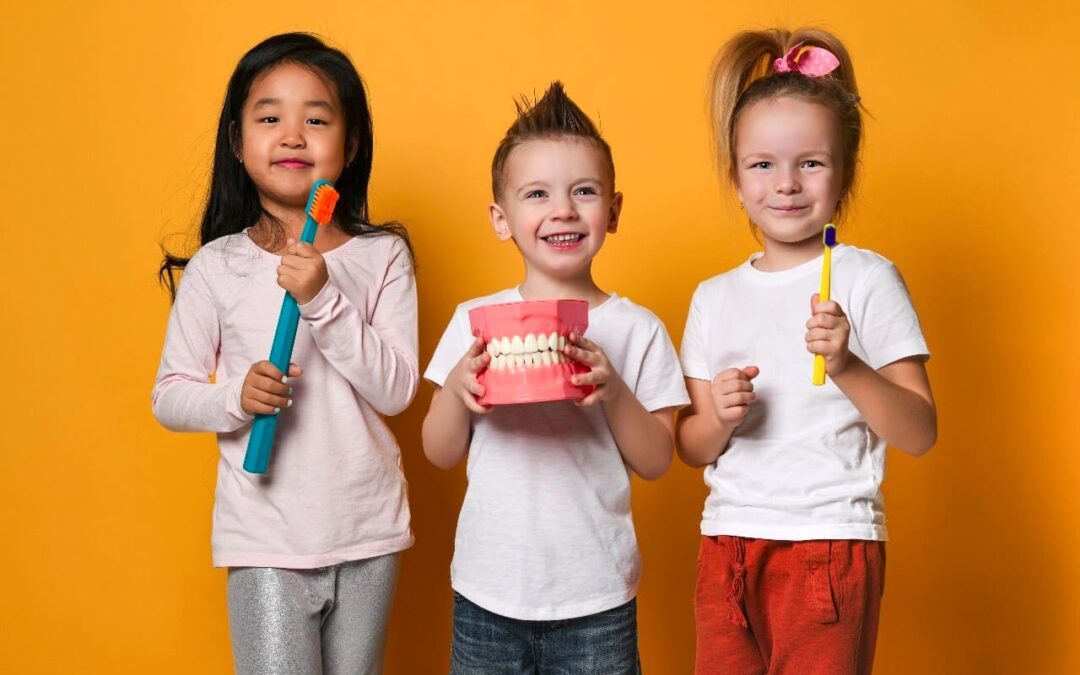
by Miranda Booher | Jul 4, 2022 | Children's Oral Health, Community News, Dentistry News
While the majority of our population is in fact, not dental experts, society actually as a whole has a few very firm (and correct) understandings and expectations when it comes to the topic of healthy teeth.
We expect our babies to grow the first few adorable little whites within the first year. Most homes generally have a routine to brush teeth in the mornings and again at night before bed. We teach our children to put their lost teeth under their pillow for the tooth fairy, and we associate healthy smiles to the general color category of white. So, what does it mean then, when one of your kids’ pearlies is actually a grey color?
A grey tooth is what we call a necrotic tooth or pulp necrosis. This means that the pulp of the tooth has suffered damage to its blood supply. Without proper blood supply, the tissue begins to die, thereby changing the color of the tooth from white to grey.
Why is My Child’s Tooth Grey?
The potential causes of a grey tooth include the following:
- Dental trauma – this is the most likely cause of a necrotic tooth in children. One of the reasons we strongly advise parents to invest in mouth guards for kids who play sports of any kind is because the use of mouth guards can actually reduce the chances of a dental trauma injury by 73%-83%. Nevertheless, even with the use of mouth guards while engaged in sports activities dental trauma injuries can occur. An accidental elbow to the face, or a head first tumble for your walking toddler. These injuries can occur even with the best of safe guards in place. If your child has suffered a dental injury such as a chipped tooth or a tooth has been knocked loose or all the way out, follow these steps and give us a call immediately. Quick reactions can save the tooth.
- Severe and untreated tooth decay – this cause is less likely if you’re keeping your kids to the recommended biannual cleaning and checkup schedule in addition to encouraging healthy dental hygiene routines at home.
- Gum disease – another cause avoidable with healthy dental hygiene at home and routine checkups and cleanings at your local pediatric dentist.
Can a Grey Tooth Be Saved?
Actually, a grey tooth can be saved if action is taken quickly enough. When the whole of the tooth is mostly intact in spite of the dead or dying pulp tissue within, measures can be taken to save the tooth itself. For this we may perform a pediatric pulpotomy or a root canal.
This means we must first create a hole within the enamel to get inside the tooth to remove the infected or decaying pulp from the inside of the tooth. Next a healing medicine is applied to soothe the nerves and treat any bacteria attempting to grow (which can spread to the root and cause an abscess if untreated). Once that part of the treatment is completed, we reseal the entry and create a cap to cover the tooth. If the tooth in question is a baby tooth (primary tooth) we may opt to cover the entry with a composite filling instead of a cap. A composite filling is a more economic route, and only appropriate in the case of a primary tooth because the tooth’s lifespan is only a few years as opposed to if it were a permanent tooth in question.
Does a Dead Baby Tooth Need to Be Pulled?
In general, we avoid tooth extractions whenever possible. The primary teeth, serve as place holders for their permanent teeth and our bodies generally allow primary teeth to loosen and fall out naturally in accordance for the timing of the eruption of the permanent teeth. Additionally, primary teeth serve to help our children chew and eat foods properly and develop proper speech patterns.
Nevertheless, if your child has a necrotic tooth that is causing severe pain, an infection in the gums or spreading to other teeth, a pediatric pulpotomy may not be appropriate. In these rare circumstances, we may need to simply extract the tooth. For this to be necessary your child would likely be experiencing severe tooth pain, therefore we urge parents to listen to their children when they complain of tooth pain. Don’t wait for it to become severe before scheduling an appointment for a consult.
What if the Teeth Have Grey Spots?
If the tooth or teeth are not wholly grey but instead have grey or black spots or streaks, that doesn’t necessarily mean necrosis is to blame.
These grey colored spots may be indicative of too much iron in their diet. Iron supplements, fortified cereals, or iron-rich water may be to blame. When iron is the culprit, assist your child with tooth brushing for a time and they will disappear.
Grey spots could also be an indication of over exposure to fluoride. Is your child using an appropriate amount of toothpaste when they brush? Are they spitting out the toothpaste or swallowing it instead?
If grey lines or spots are visible near the gum line, they could be indicative of decay, because that area of the tooth can be the hardest for kids to brush properly. Are you taking a turn to help them brush at night before bed?
Call Utah Pediatric Dentists and Schedule a Consult
In any of the aforementioned cases, it is important to seek advice and assistance from your pediatric dentist. We can determine the cause, and appropriate treatment while providing you and your child with reassurance and choices about the best way to move forward with a healthy smile.

by Miranda Booher | May 25, 2022 | Children's Oral Health, Community News, Uncategorized
Summer’s here and we’re so excited about it! A break from the homework and the out-of-the-house rush in the mornings without forgetting backpacks or snack packs is due. Pool parties, barbecues, grill parties, sports team tournaments, rec league games, and all the other summer fun activities are already bringing smiles to your kids’ faces and sweetening their dreams. Nevertheless, those same activities that make them smile, can be hard on those very same smiles. What do we mean by that? Well, the snacks, the drinks, and the types of foods we ingest at these parties can be harmful to our teeth. With this in mind, we’ve put together a list of tips for summer fun to help you and your kids take care of their smiles.
Hot Tips for Healthy Summer Smiles
- Choose Crushed Ice: This one may seem like it’s coming at you out of the left-field, but it’s a great tip that’s easy to gain your kids’ approval for. The truth is, that crunching on ice cubes is harmful to the enamel on our teeth. Crunching ice can crack the enamel of the tooth which can result in cold sensitivity and increased vulnerability to cavities. Add to that, the potential for actually chipping or cracking a tooth, which is a legitimately shocking and even painful experience, do we need to say more? Bottom line, everyone wants ice-cold drinks, especially in the Utah summer heat, and we can’t begrudge anyone that desire, so here’s your workaround. Choose crushed ice whenever possible!
- Mouth Guards Make a Difference: Just because school sports are on a break, doesn’t mean your kids won’t be playing this summer. Whether it’s competitive tournaments, or a more casual rec league doesn’t matter when it comes to the propensity for dental emergencies. Mouth guards are essential for any sport. A large portion of our emergency dental visits to the office are a result of a broken or chipped tooth from a ball game, a bike crash, or simply falling on the wet, slippery surface by the pool. Mouth guards will protect their teeth in those types of situations, even the more economical versions found at your local store. Give us a call to learn more about a custom-fitted mouth guard that will have the advantage of increased comfort.
- Ensure Crunchy Veggies Are Available: You won’t be the menu master at other people’s home parties, but you sure are for your own! When you’re planning a summer bash, make sure you put out vegetable platters with crunchy carrots, celery, bell pepper, broccoli, cauliflower, and more. Go further, and integrate these vegetables into your daily snack options for your kids. Take a morning or afternoon and prep them by cleaning, peeling, and slicing so they’re easy to grab or pack if your kids are headed out the door. Not only are vegetables rich in vitamins, but the crunchiness serves as a scrubber for the teeth, helping to remove sugars or other food debris that is otherwise lodged in their teeth. Also, why not bring a veggie platter to your neighbor’s pool party?
- Lemonade in Moderation: Who doesn’t love a lemonade or a limeade in the summertime? Your teeth, that’s who. These delicious summer drinks are a double whammy on teeth: the citrus runs an assault the enamel while the enormous amount of sugar dives in and hides in the nooks and crannies looking for vulnerabilities. We generally prefer to avoid doling out a hard ‘no’ on anything as we know that kids often love what they can’t have, yet we encourage these types of drinks to be limited. Also, after a limeade or a lemonade follow it up with a generous swig of water. Swish the water around and spit it out to help wash away residue citrus and sugars.
- Refillable Water Bottles: We love the benefits of water, as demonstrated in the aforementioned lemonade tip. In general, swishing and then spitting a mouthful of water after any snack or meal that has sugars, sauces, or stickiness is highly recommended. When your kids are out and about, they are less likely to splurge on a soda or other sugary drink if their water bottle is already on hand. The same goes for you, parents. Carrying around your water bottle sets a positive example for your kids, and will help you moderate the temptation to buy yourself a cold sugary drink when you’re sitting in the sun watching a game, or hanging by the pool or grill. Other benefits to utilizing refillable water bottles include the fluoride benefit from the city’s water supply, and the cash benefit as well. $1.50 (or more) every day adds up.
- Travel Toothbrush and Toothpaste: At any local drugstore, you can find travel-sized toothpaste and toothbrushes that will fit easily into your purse, your kid’s backpack or sports bag, and even the console of your car. Make brushing teeth a priority, even when your family is on a road trip or weekend getaway.
- Schedule a Cleaning: The majority of dental insurance plans these days cover two cleanings per year. When was the last time your kids had a cleaning? If you can schedule around vacations, getting in for cleanings during the summer is easier than pulling them out of school, or utilizing the short afternoons Monday through Friday during the school year. Utilize your dental plan to its maximum benefit, and schedule cleanings for your kids this summer.
Call Utah Pediatric Dentists Today
We have three fully equipped and staffed office locations waiting to hear from you. Our team of staff is dedicated to happy kids with healthy smiles. We’re just a phone call away, and look forward to hearing from you! Happy summer, we hope you enjoy it to the fullest!

by Miranda Booher | Apr 18, 2022 | Dentistry News
With our busy schedules and seemingly endless to-do lists, it is easy to put off taking our kids to the dentist – we probably don’t go ourselves unless we are suffering from unendurable pain. What doesn’t kill us makes us stronger, right? This expression might have some truth to it, but it certainly does not apply to our oral health. When it comes to your kids’ pearly whites, prevention and early treatment are key to ensuring not only your children’s oral health but their overall physical health as well.
Read on to learn more about pediatric dentistry and where to find the best pediatric specialists in Salt Lake City.
What Is a Pediatric Dentist?
A pediatric dentist is a specialist who provides preventive and therapeutic oral health care for infants and children through adolescence, including those with special health care needs. Pediatric dentists provide care, carry out research, and teach in diverse clinical and institutional settings. They collaborate with other health care providers and
members of social disciplines for the wellbeing of children.
To become a pediatric dentist, after four years of dental school, a dentist must complete a 24-month advanced education program accredited by the Commission on Dental Accreditation of the American Dental Association. Pediatric dentistry programs cover a variety of disciplines, techniques, procedures, and skills which are adapted to the particular needs of infants, children, adolescents, and those with special health care needs.
The work-scope of a pediatric dentist encompasses all of the following:
• Behavior guidance (for example, pacifier use and thumb sucking)
• Care of medically and developmentally compromised and disabled patients
• Supervision of orofacial growth and development, including early assessment and treatment for straightening teeth and correcting an improper bite (orthodontics)
• Caries prevention, including cleaning and fluoride treatments, as well as nutrition and diet recommendations
• Repair of tooth cavities or defects
• Management of gum diseases and conditions including ulcers, short frenulae, mucoceles, and pediatric periodontal disease
• Care for dental injuries (for instance, fractured, displaced or knocked-out teeth)
• Pharmacological management, including sedation
Why Is Pediatric Dentistry Important?
As any parent knows, children usually feel nervous or even terrified of the simplest medical procedures – and unfortunately visits to the dentist are not the exception. Thankfully, pediatric dentists know how to examine children and interact with them in ways that put them at ease. Furthermore, the entire office is geared towards children from the equipment to the decoration – don’t underestimate the soothing effect of a set of Peppa Pig scrubs!
Not only do pediatric dentists win over their patients with fun outfits and decorations, but – more importantly – they also explain and demonstrate to kids step by step what they will do before they even ask the children to open their mouths. For example, a water flosser looks scary even to adults, but if children have seen how it works and maybe felt the water on their hands, instead of being afraid, they might think it seems fun and look forward to a cleaning.
Is Pediatric Dentistry a Modern Invention?
As parents, it often seems like the world our kids are growing up in is vastly different from the one we grew up in, and it is hard to distinguish between true improvements/necessities on one hand and inventions of consumer society on the other. However, in the case of pediatric dentistry, the American Dental Association officially recognized this specialty in 1940, and the American Academy of Pedodontics was founded in 1947. Furthermore, the first book on children’s dentistry dates all the way back to 1742. In other words, pediatric dentistry is by no means a new fad.
Moreover, taking kids to the dentist nowadays is even more important than it was in the past. According to the latest National Health and Nutrition Examination Survey (1999-2004), tooth decay in children ages two to eleven has been increasing since the mid-1990s with younger children being more severely affected. The aforementioned survey found that 42% of children two to eleven have had dental caries in their primary teeth, so if you haven’t yet taken your children to the dentist, it is imperative that you do so; remember that with oral health sooner is always better.
Kids Dentist Near Me
If you live in or around Salt Lake City, Utah, we have three conveniently located pediatric dentistry offices for you to choose from: in Redwood, in South Davis, and in Herriman. Click on the location nearest you to get to know us a little better – the more you know us, the more you’ll love us; then call to schedule your child’s appointment today!

by Miranda Booher | Feb 7, 2022 | Children's Oral Health, Dentistry News
February is the month of: candied chalky hearts, gummy jelly beans, valentines, romance, the disappearing and reappearing 29th (leap year), and children’s dental health awareness. How’s that for a bit of irony? In the month of the holiday that literally only celebrates love through chocolate and candy is also the month that as a nation, we take the time to focus our awareness and attention on the dental health of our youthful generations.
Children’s dental health awareness started as merely a day of observance, the 8th of February, by the American Dental Association (ADA) in 1949, and in 1981 it was lengthened to the entire month! Maybe as Valentine’s Day candy furor intensified over the years the entire month was decided upon as necessary to counter the cavity consequences?
Regardless of the motivation behind the month, as pediatric dentists in South Davis and the surrounding area, we love this topic. Our vision is to see happy and healthy smiles in all the children of our communities. That no child be prevented from receiving dental care due to fear, anxiety, cost, accessibility, or convenience. Knowing that, surely you aren’t surprised.
Every year, the ADA announces a theme for the month of awareness, and this year the theme is: ‘Sealants Make Sense’.
Sealants Make Sense
Dental sealants are an important part of children’s dental health that are a preventative measure taken primarily for children. Perhaps in part because they cannot be applied to any teeth that already have fillings, but also due to the fact that statistically cavities are still very common in children.
Current data from the Centers for Disease Control and Prevention (CDC) has the following statistics regarding cavities and kids:
-
About 1 of 5 (20%) children aged 5 to 11 years have at least one untreated decayed tooth.1
-
1 of 7 (13%) adolescents aged 12 to 19 years have at least one untreated decayed tooth.1
-
Children aged 5 to 19 years from low-income families are twice as likely (25%) to have cavities, compared with children from higher-income households (11%).1
So, why do sealants make sense? On the grounds that cavities are more statistically likely to occur in your children’s teeth than yours (you are a routine tooth brushing and flossing adult, right?) sealants are an effective protection that is applied directly to the enamel of the tooth by covering and sealing to the tooth thereby preventing any lingering food or bacteria from causing decay of the enamel. The molars are the most frequent beneficiaries for sealants: owing to the pits, grooves, and fissures along the top that conduct the arduous and integral work of chewing and grinding up our food.
Those pits, grooves, and fissures are favorite hiding spots for bacteria, plaque, and bits of food. While it’s absolutely important that you teach your little ones the correct brushing technique, through the age of six, you really should also take a turn as well. Nevertheless, dental sealants are typically covered by most (although not all, sadly) dental insurance and dental health plans as a result of evidence based studies and clinical trials that have shown a staggering effect on reducing the risk of cavities.
Science Says Sealants Make Sense
Let’s explore a little further the aforementioned staggering impact dental sealants have on dental health. What does the science say about sealants?
In 2016, a clinical review of 23 scientific studies of the topic titled, ‘Sealants for preventing and arresting pit-and-fissure occlusal caries in primary and permanent molars
A systematic review of randomized controlled trials—a report of the American Dental Association and the American Academy of Pediatric Dentistry‘, was published in the Journal of the American Dental Association. The review examined the effectiveness of dental sealants in children, adolescents, and adults and came to the following conclusions:
-
“Participants who received sealants had a reduced risk of developing cavities in permanent molars by 80% when compared with those who did not receive sealants.
-
When compared with fluoride varnishes, the authors found that sealants reduced the incidence of cavities after 7 or more years of follow-up.
-
The evidence base supporting sealants suggests that they are effective and safe to prevent or arrest the progression of cavities compared with a control without sealants or fluoride varnishes.”
Sealants Are Easy to Apply and a Pain Free Procedure
Once you’ve decided sealants make sense for your kids, it’s a quick process. First, we clean the chosen teeth thoroughly. Once the teeth are cleaner than ever, a gel is applied that will abrade the surface slightly to allow the sealant to make a truly tenacious bond. The sealant itself we apply in liquid form and then utilize blue light activation to harden it which completes the procedure.
Suggestions for Dental Health Awareness Activities with Your Kids
We’ve said it before, yet we truly must emphasize how the attitude of the parent towards dental health directly impacts the attitude of the child. When you apply time, energy, and focus to prioritizing dental health not only for your kids but yourself as well, they will notice. You don’t have to be a dentist or a school employee to take up the mantel of sharing dental health awareness with your kids and/or community.
The ADA has created several printable PDF documents of coloring pages and word games that you can print for your kids: find them by clicking here. Share them with your daycare, preschool, church, and community center.
Make an Appointment for Dental Sealants
Don’t wait until your next scheduled cleaning to do dental sealants for your kids. If they have molars, baby or permanent, then they have pits and grooves tempting those bacteria and food bits. We apply dental sealants to both baby and permanent teeth because proper care for your child’s baby teeth is just as important as it is for their permanent teeth. Give us a call today and we’ll make an appointment that works for your family.

by Miranda Booher | Jan 10, 2022 | Children's Oral Health, Dentistry News
The new year is here folks, and we’re going to start it off right. Dental health and hygiene may not be on your radar for new years’ resolutions, but they should be! Prevention is a major part of happy and healthy smiles for children in your community, and that means more than just regular trips to your pediatric dentist. Here are our top dental health habits just for you!
Dental Health and Hygiene Habits
1. Brush teeth twice per day for two minutes. Mornings before school, and at night before bed are what we aim for. There are fun songs about brushing teeth, or time a song that your little ones enjoy and put it on repeat for two minutes. Brushing teeth should start as soon as the first tooth erupts. Read all about dental care in babies (it actually starts before the eruption) in our guide, ‘Baby Teeth: Eruption Timeline and How to Care for Them‘.
2. Include the tongue as part of brushing. We don’t always consciously think about it, but our tongues actually do quite a bit of work to clear debris between our teeth, and its very presence in the mouth means it is in contact with the same sugars and bacteria as our teeth. Be sure to incorporate a few brush strokes of the tongue into the two minutes. To learn more about how the tongue is a visual indicator of our health, read all about it in our post, ‘Is My Child’s Tongue Healthy?‘
3. Take your child to the store and let them pick out their own toothbrush. Letting them select their toothbrush will give them a sense of responsibility and ownership of their dental health. There are all sorts of fun colors and characters, so let them have some fun with it.
There are electric toothbrushes being marketed for children, however, we encourage you to research a bit before you buy. We wrote a guide for parents about this topic, ‘What’s the Best Electric Toothbrush for Kids?‘, hint (there’s only one on today’s market that has ADA approval).
4. Switch toothbrushes out every three months or sooner if you notice the bristles are worn. With frequent and proper use, those toothbrush bristles will wear out. Bristles that are worn on a toothbrush can actually harm your gums by wearing down the enamel and even causing your gums to recede. Furthermore, the fact is, worn-out bristles simply don’t clean properly. They bend away from the surface instead of stretching into the nooks and crannies of the teeth and in between.
Nevertheless, even if the bristles don’t look worn out, you need to replace it on a three-month timeline. Why? Take a look at your broom and you’ll likely notice a buildup of dust or debris on those bristles. Imagine a toothbrush to be similar to a broom. Its job is to brush away bacteria and debris on your teeth. While proper care of your toothbrush means food debris isn’t likely present, over time invisible bacteria will still build up on those bristles. For more information about proper care of your toothbrush, check out our in-depth article: “Toothbrush Care Guide: Everything Parents Need to Know”.
5. Floss at least once a day. Most parents who bring their kids into our offices will agree with our twice a day tooth brushing recommendation, and back it up by their actions. However, it isn’t uncommon to have a parent sheepishly admit that they don’t floss as often as they should. We aren’t here to shame anyone in regard to their dental habits. Odds are high that the parents who don’t floss very often, simply didn’t grow up flossing! Habits that we learn as children can stick with us throughout adulthood! Start out encouraging your kids to floss, and join them yourself. You are never too old to learn new healthy habits, and flossing is one that is a positive habit for everyone. Check out new and interesting flavors, (remember to look for the ADA seal).
6. Invest in a mouth guard for sports. Mouth injuries happen to kids, even if they aren’t playing a contact sport such as football. We recommend mouth guards should be worn for all sports, including biking and skateboarding. Studies show that wearing a mouth guard will lessen the likelihood of dentofacial injuries by more than 82%. A broken or chipped tooth, a root fracture, or a tooth knocked loose or all the way out is considered a dental emergency. Read our step-by-step guide on what to do in that type of situation to prepare yourself, ‘What Do You Do When Your Kid Breaks a Tooth?‘
7. Up your water intake! Most store-bought beverages have a shocking amount of sugar in them (or sugar substitutes) that might be tasty but are terrible for our teeth. It’s unfair to ask anyone to give up all other drinks, but we do think it’s fair to encourage you to increase the amount of water you and your kids are drinking. City water is treated with fluoride which is a vital defense for teeth. Furthermore, water will help rinse away bacteria and sugars from your meals and snacks in between your brushing routine. One way to facilitate more water throughout the day is utilizing a refillable water bottle and taking it with you on errands, and sending it in backpacks to school. When water is within easy reach, your kids are more likely to drink more of it.
Start Off the New Year by Scheduling a Checkup and Cleaning!
It’s never too late to prioritize the dental health of your children (and yourself!) All of the above tips for healthy habits can be applied to each member of your family, regardless of age. Utilize those dental benefits on your insurance this year, and start out by scheduling a checkup and dental cleaning for each of your kids. Preventative care is the bedrock of happy healthy smiles in our community. Give us a call, and we’ll help you start the year of dental strong.






Recent Comments